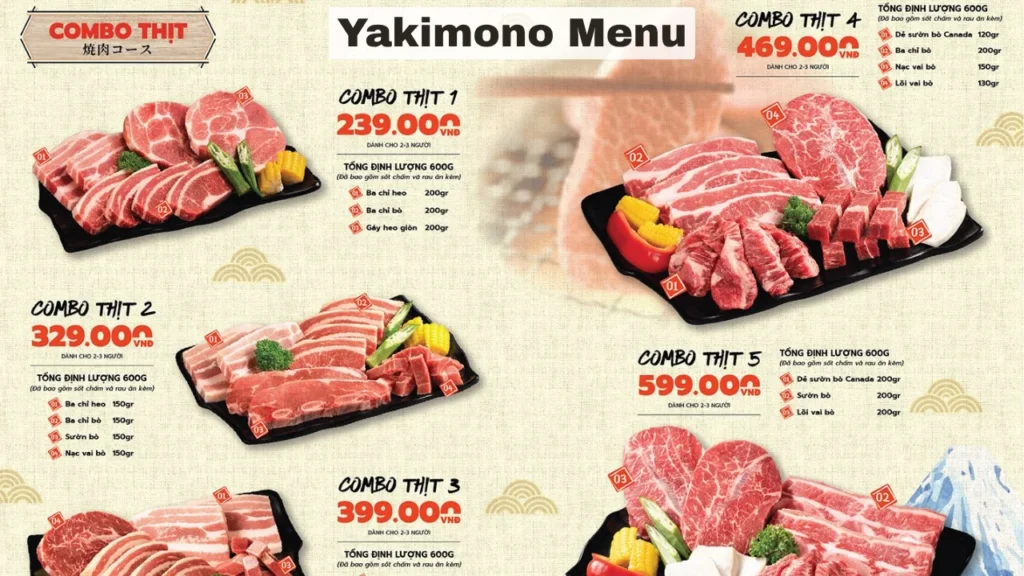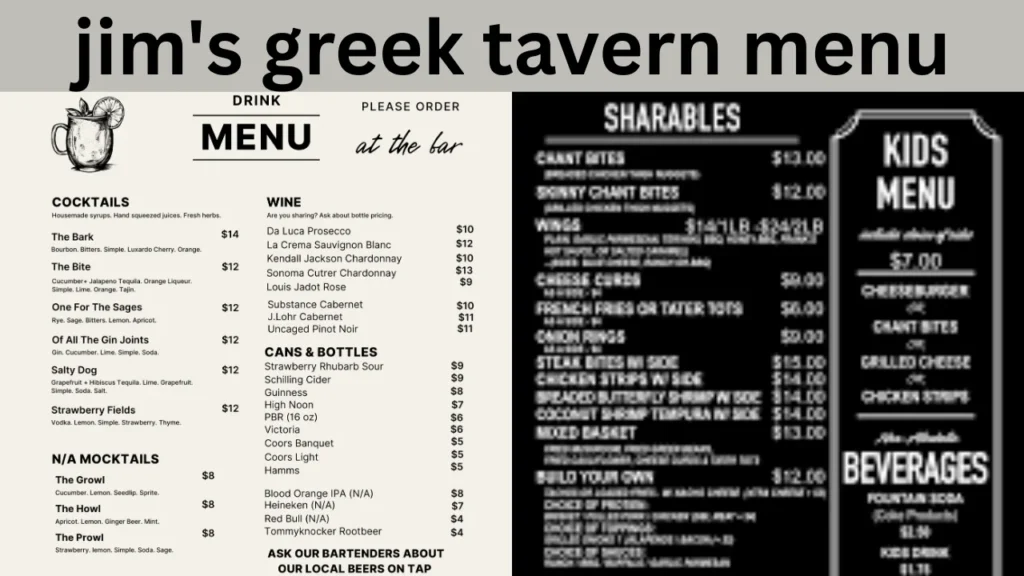Japanese cuisine is famous for clean flavors, simple techniques, and deep respect for ingredients, and one of the best examples of this is the yakimono menu. Many people enjoy this part of the menu because it features grilled dishes cooked using direct heat, balanced seasoning, and fresh ingredients. Even modern dining places like Olivigna Restaurant include yakimono dishes because guests love the smoky flavors and light textures that come from Japanese grilling. Yakimono is not just a food category; it represents a cooking tradition that highlights natural taste and expert control of fire.
What is Yakimono Menu?
A Yakimono is a section of a Japanese restaurant menu that features dishes cooked using grilling, searing, or pan-frying over direct heat. The word “yakimono” comes from the Japanese terms “yaki,” meaning grilled, and “mono,” meaning things, so it translates to “grilled things.”
This menu usually includes items like chicken skewers, grilled fish, beef, pork, and vegetables that develop a smoky flavor and crisp texture from high heat. Seasoning is kept simple with salt, soy glaze, miso, or light sauces, allowing the natural taste of the ingredients to stand out. A Yakimono highlights fresh food, clean flavors, and the traditional Japanese art of cooking with fire.
Owners Info
The owners of restaurants that offer a Yakimono are typically chefs or restaurateurs who specialize in Japanese cuisine and understand the traditions of grilling. These owners often have experience with techniques like charcoal grilling, yakitori preparation, and classic Japanese flavor profiles.
Many Yakimono-focused restaurants are owned by people who value authentic cooking methods, fresh ingredients, and the cultural roots of Japanese food. Whether the restaurant is family-run, chef-owned, or part of a larger dining group, the owners usually prioritize quality, consistency, and the unique smoky taste that defines yakimono dishes.
Location
The location of the Yakimono in a Japanese restaurant is usually found in the middle or later part of the menu, often placed after lighter dishes like appetizers, sashimi, or cold items. Restaurants position it there because yakimono dishes are slightly heavier and are meant to be enjoyed as main plates or shared items.
In some izakaya-style restaurants, the Yakimono may appear as a separate grilling section alongside fried dishes or hot plates. No matter where it appears, this section is easy to spot because it is dedicated to grilled items such as skewers, fish, meat, and vegetables prepared over direct heat.
Dishes At Yakimono Menu

Here is the description of dishes available at Yakimono along with prices:
Chicken Yakitori
Juicy chicken skewers grilled over smoky high heat.
| Feature | Detail | Notes |
|---|---|---|
| Dish Type | Chicken Skewers | Charcoal Grilled |
| Texture | Juicy, Smoky | Soft Inside |
| Flavor | Salt or Soy Glaze | Lightly Charred |
| Price | $8 – $12 | Per Serving |
Miso Eggplant
Soft eggplant glazed with sweet miso and lightly charred.
| Feature | Detail | Notes |
|---|---|---|
| Dish Type | Grilled Eggplant | Miso Glazed |
| Texture | Soft, Tender | Slight Char |
| Flavor | Sweet, Savory | Balanced Taste |
| Price | $7 – $10 | Per Plate |
Beef Short Ribs
Tender beef ribs grilled with a sweet soy finish.
| Feature | Detail | Notes |
|---|---|---|
| Dish Type | Grilled Beef Ribs | Soy Glazed |
| Texture | Tender, Meaty | Crispy Edge |
| Flavor | Rich, Umami | Deep Smokiness |
| Price | $14 – $20 | Per Plate |
Salmon Teriyaki
Fresh salmon grilled and coated in smooth teriyaki glaze.
| Feature | Detail | Notes |
|---|---|---|
| Dish Type | Grilled Salmon | Teriyaki Glaze |
| Texture | Flaky, Soft | Slight Crisp |
| Flavor | Sweet-Savory | Mild Smoky |
| Price | $12 – $18 | Per Portion |
Mackerel Shioyaki
Salt-grilled mackerel with crispy skin and rich flavor.
| Feature | Detail | Notes |
|---|---|---|
| Dish Type | Salt-Grilled Fish | Crispy Skin |
| Texture | Firm, Moist | Charred Skin |
| Flavor | Clean, Salty | Strong Aroma |
| Price | $10 – $15 | Per Plate |
Pork Belly Skewers
Crisp-edged pork belly skewers cooked over direct flame.
| Feature | Detail | Notes |
|---|---|---|
| Dish Type | Pork Skewers | Grilled |
| Texture | Crispy, Soft | Fatty Richness |
| Flavor | Savory, Bold | Smoky Taste |
| Price | $8 – $12 | Per Skewer Set |
Grilled Asparagus
Fresh asparagus spears grilled until smoky and tender.
| Feature | Detail | Notes |
|---|---|---|
| Dish Type | Vegetable Grill | Light Seasoning |
| Texture | Tender-Crisp | Slight Char |
| Flavor | Fresh, Earthy | Mild Smoky |
| Price | $6 – $9 | Per Plate |
Chicken Meatballs (Tsukune)
Soft chicken meatballs glazed and grilled for extra flavor.
| Feature | Detail | Notes |
|---|---|---|
| Dish Type | Chicken Meatballs | Skewered |
| Texture | Soft, Juicy | Glazed Surface |
| Flavor | Sweet-Savory | Charred Edges |
| Price | $8 – $11 | Per Skewer Pair |
Grilled Squid (Ika Yaki)
Tender squid grilled with a light soy brush.
| Feature | Detail | Notes |
|---|---|---|
| Dish Type | Grilled Squid | Soy Brushed |
| Texture | Tender, Chewy | Light Crisp |
| Flavor | Mild, Oceanic | Smoky Hint |
| Price | $12 – $16 | Per Serving |
Yellowtail Collar (Hamachi Kama)
Rich yellowtail collar grilled for deep, savory taste.
| Feature | Detail | Notes |
|---|---|---|
| Dish Type | Fish Collar | Charcoal Grilled |
| Texture | Rich, Tender | Crispy Outside |
| Flavor | Deep, Savory | Naturally Oily |
| Price | $14 – $22 | Per Portion |
Corn with Miso Butter
Sweet corn grilled and topped with melted miso butter.
| Feature | Detail | Notes |
|---|---|---|
| Dish Type | Grilled Corn | Miso Butter |
| Texture | Soft, Juicy | Charred Kernels |
| Flavor | Sweet, Savory | Melted Butter |
| Price | $5 – $7 | Per Piece |
How the Yakimono Tradition Started
The tradition behind the yakimono goes back many years in Japanese culture when people grilled fresh fish and vegetables using only salt and fire. These early grilled foods highlighted purity and freshness. As Japanese cuisine developed, people added sauces like soy glaze, miso, and sweet teriyaki, yet the spirit remained the same: simple seasoning and direct flame. Today, restaurants still follow these traditions by grilling dishes over charcoal or metal plates. Chefs focus on balance and respect for the ingredient, which is why yakimono dishes feel light but full of flavor.
Opening and Delivery Timings
The opening and delivery hours for restaurants offering a Yakimono usually follow standard Japanese dining times, with lunch service in the early afternoon and dinner service in the evening. Many restaurants also provide delivery during peak meal hours to ensure fresh, hot grilled dishes reach customers on time.
| Service Type | Hours |
|---|---|
| Lunch Hours | 11:30 AM – 2:30 PM |
| Dinner Hours | 5:00 PM – 10:00 PM |
| Delivery | 12:00 PM – 9:30 PM |
How Yakimono Dishes Are Prepared
Yakimono dishes are cooked using several heating methods. The most traditional method uses charcoal because it adds a clean, rich aroma. Chefs use a special type of charcoal called binchotan, which burns hotter and cleaner than normal charcoal. This helps cooks grill food evenly. Other restaurants use metal plates, flat grills, or pans, especially when cooking indoors. No matter the method, the focus remains on heat control. The grilled items on a yakimono menu depend on timing and steady attention because even small changes in heat can alter flavor.
Seasoning is another key part of yakimono cooking. Some dishes use only salt, called “shioyaki”, which highlights natural flavor. Others use tare glaze made from soy sauce, sugar, and mirin, which creates a sweet and savory finish. Miso and citrus pepper paste also appear in yakimono seasoning. These flavors enhance the dish without overpowering the ingredients.
Why the Yakimono Menu Is Loved by Many

The yakimono is popular because it offers natural flavors, healthy options, and delicious smoky textures. The grilling method uses minimal oil, making dishes lighter than fried or breaded options. The variety of proteins and vegetables ensures everyone finds something they enjoy. Many people appreciate how yakimono dishes feel both comforting and refined.
What Happens When You Dine At Yakimono
When you dine at a restaurant with a yakimono, you will notice that dishes usually arrive quickly because grilling is a fast cooking method. The smell of charcoal or seared meat adds to the experience. In many places like Entrata Restaurant, the yakimono section appears after small starters and before main soups or noodle dishes. This position helps diners enjoy grilled plates as either light main courses or shared items.
Yakimono dishes also pair well with simple sides like rice, miso soup, and small pickles. These side items balance the smoky flavor of the grilled foods. Most yakimono servings come in small or medium portions, which makes them easy to share. This sharing style creates a cozy and friendly dining experience.
Customer Reviews
Here are customer reviews from Google about Yakimono:
- “We loved the variety on the menu. The seafood tasted especially fresh, and the seasoning was just right.”
- “The restaurant gets busy, but the atmosphere is lively. The staff handled the rush very well.”
- “Great flavors and great portions. The yakitori dishes were a highlight of our meal.”
- “The environment felt modern and stylish. It made the dining experience more enjoyable.”
- “Some items took a while to arrive, but everything tasted great once it came. Worth the wait.”
Final Thoughts
The yakimono menu represents the heart of Japanese grilling, combining tradition, skill, and fresh ingredients. Whether you try chicken skewers, grilled fish, or smoky vegetables, each dish highlights the beauty of simple cooking. With its clean flavor and warm presentation, yakimono food creates a memorable dining experience. Understanding the menu makes it easier to choose dishes you love and enjoy the full depth of Japanese grilling.



